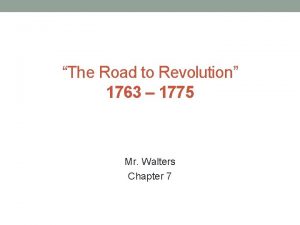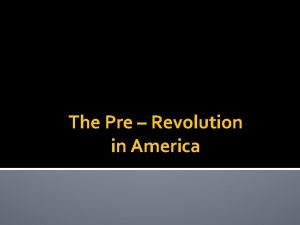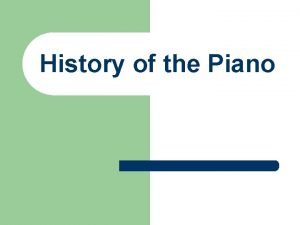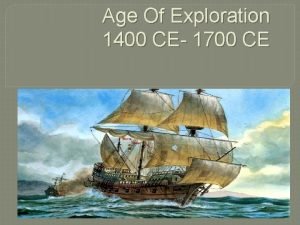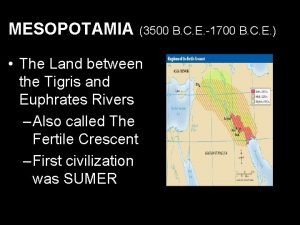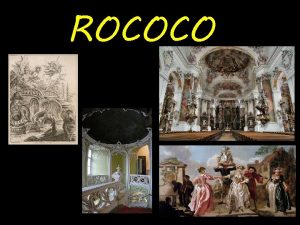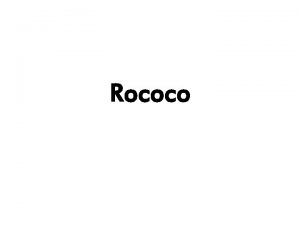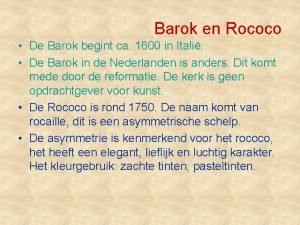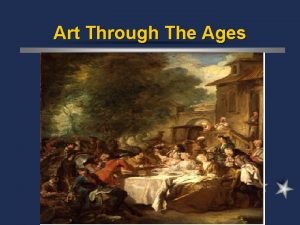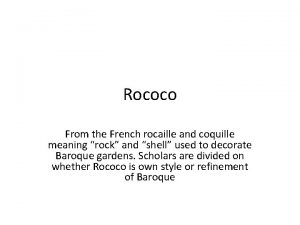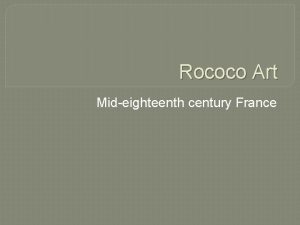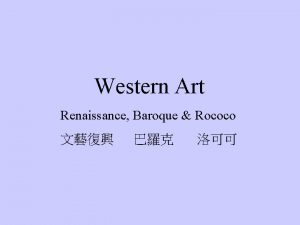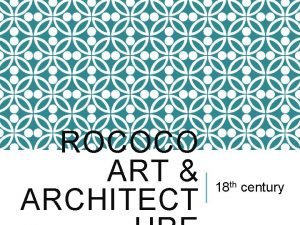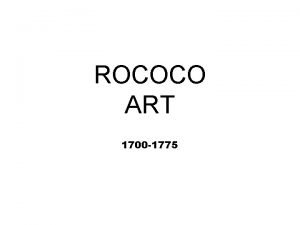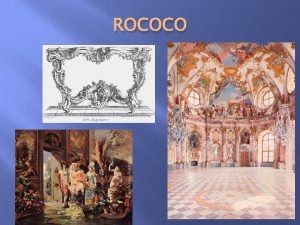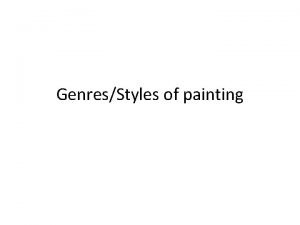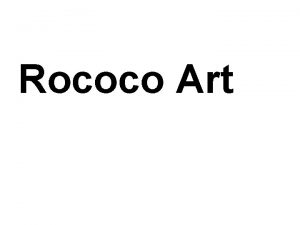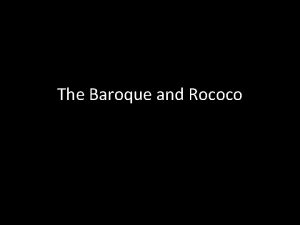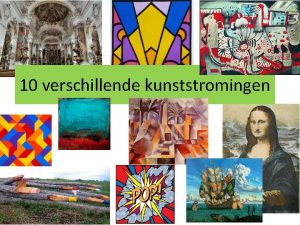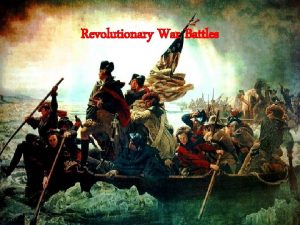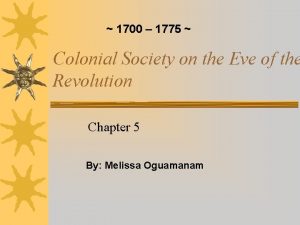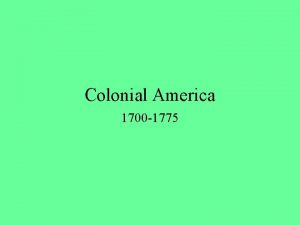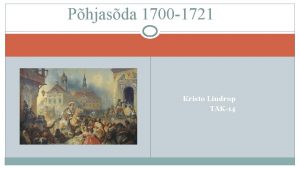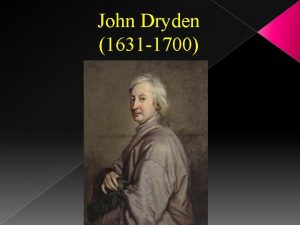Chapter 11 5 Rococo 1700 1775 Rococo a



































- Slides: 35

Chapter 11. 5 Rococo: 1700 -1775 Rococo, a style first developed in France, was typified by paintings that were more youthful, playful and lighthearted than earlier Baroque artwork. Rococo artwork has a decorative, festive look, generally including idealized figures at leisure in parklike settings. This style was not popular throughout all of Europe; the English and their American colonies preferred the more serious nature of Baroque art, and extended that style into the later 1700 s.

Antoine Watteau (1684 -1721) The Gamut of Love Oil on canvas, 1717 20 x 23” French Rococo style was typified by this artist’s work. Watteau created shimmering surfaces that sparkle with life and happy playfulness. His work shows scenes of idealized, elegant society, or comedic actors in park-like settings.

Antoine Watteau (1684 -1721) The period of French Rococo was typified by this artist’s work.

Antoine Watteau (16841721) The period of French Rococo was typified by this artist’s work.

Antoine Watteau (16841721) The period of French Rococo was typified by this artist’s work.

Antoine Watteau (16841721) The period of French Rococo was typified by this artist’s work.

Jean-Honore Fragonard (1732 -1806) The Swing, 1766 Oil on canvas, 32 x 35” This French artist created a luxuriant park full of colorful flowers bathed in a soft light with graceful, floating figures. His portraits are idealized.

Jean-Honore Fragonard (1732 -1806)

Jean-Honore Fragonard (1732 -1806)

Jean-Honore Fragonard (1732 -1806)

Francois Boucher (1703 -1770) The Fountain of Love 1748 oil on canvas 116 x 133”

Jean-Baptiste. Simeon Chardin 1699 -1779) The Attentive Nurse, 1738 Oil on canvas 18 x 15” GENRE PAINTING: Refers to the practice of painting subjects from everyday, common life. Chardin was interested in representing the importance and value of common people in society. He tends to show sturdy, heavy, coarse materials instead of delicate finery of society’s upper class people.

Jean-Baptiste. Simeon Chardin (1699 -1779) Simple forms are placed against a neutral background; the subject matter of humble objects is the exact opposite of the typical Rococo paintings of flamboyance and carefree elegance.

Jean-Baptiste. Simeon Chardin (16991779) This French artist portrayed the life of the middle class household with a quiet dignity reminiscent of the Dutch masters. His still lifes are composed of firmly placed and solidly rendered objects that represent the life of common man.

Jean-Baptiste. Simeon Chardin 1699 -1779) Still life with Plums 1758 Oil on canvas 16” x 20”

Jean-Baptiste -Simeon Chardin 1699 -1779)

Jean-Baptiste -Simeon Chardin 1699 -1779)

Jean-Baptiste -Simeon Chardin 1699 -1779)

Jean-Baptiste -Simeon Chardin 1699 -1779)

Jean-Baptiste -Simeon Chardin 1699 -1779)

Jean-Baptiste -Simeon Chardin 1699 -1779)

Antonio Canaletto (1697 -1768) The Basin of San Marco, oil on canvas, 1740

Sir Joshua Reynolds (1723 -1792) Oil on canvas Reynolds returned to his native England after traveling through Europe and studying Renaissance artwork in Rome. He lectured on art theory and received a tremendous number of portrait commissions.

Sir Joshua Reynolds (17231792) Oil on canvas Often his figures were placed in Classical settings to enhance their nobility, creating an artificial feeling. Here the contemporary woman seems to be living in past times.

Sir Joshua Reynolds (1723 -1792) Oil on canvas. The huge size of his portraits and the grand settings he devised would often flatter the subjects, making them seem more important than they actually were.

Thomas Gainsborough (1727 -1788) Oil on canvas Gainsborough became one of England’s most popular portraitists, although he preferred landscape painting. He often included large areas of open landscape as backgrounds for his subjects.

Thomas Gainsborough (1727 -1788) Robert Andrews and his Wife, 1750 Oil on canvas 28 x 48” The loose brushstrokes masterfully catch the glint of light on rustling fabrics. Gainsborough often elongated the figures, making his subjects seem regal and elegant

Thomas Gainsborough (1727 -1788) The Blue Boy 1770 Oil on canvas

John Singleton Copley (1738 -1815) American Paul Revere Oil on canvas 35 x 28” 1770 This hard-edge style of painting in Colonial America was different from English art of the time. Copley was self-taught, developing his style after carefully observing the paintings of European artists who were working in America.

John Singleton Copley American Watson and the Shark Oil on canvas This was inspired by an event that took place in Cuba in 1749. Fourteen -year-old Brook Watson, an orphan serving as a crew member on a trading ship, was attacked by a shark while swimming alone in the harbor. His shipmates, who had been waiting on board to escort their captain ashore, launched a valiant rescue effort. Watson eventually became a successful merchant in London. It is likely he commissioned the painting from Copley, whom he probably knew through members of the artist's family.

Benjamin West American The Death of General Wolfe Oil on canvas

Benjamin West American Penn and the Treaty with the Indians Oil on canvas

Gilbert Stuart (1755 -1828) American Portrait of George Washington Oil on canvas Stuart studied painting under Benjamin West in London. Most of his career was dedicated to painting the political leaders of the newborn United States of America.

Gilbert Stuart American Portrait of John Adams Oil on canvas

Gilbert Stuart (1755 -1828) American Mrs. Richard Yates Oil on canvas 30 x 25” 1794 Stuart did not flatter his subjects, preferring instead to paint the plain visual facts. His lively brushstrokes are sure, and his sense of light and color are strong.
 1750 1825
1750 1825 1775-ben született magyar matematikus
1775-ben született magyar matematikus 1775-mr4
1775-mr4 Ticonderoga war 1775 winner
Ticonderoga war 1775 winner Forensic science meaning
Forensic science meaning May 1775
May 1775 May 1775
May 1775 May 1775
May 1775 May 1775
May 1775 Request mast
Request mast Map lexile range
Map lexile range Nfpa 1701
Nfpa 1701 1700 piano
1700 piano 1700 ce
1700 ce 3500 + 1700
3500 + 1700 Esapideak zerrenda
Esapideak zerrenda Rivoluzione agricola 1700
Rivoluzione agricola 1700 1700 luvun aatesuunta
1700 luvun aatesuunta Rotazione quadriennale rivoluzione industriale
Rotazione quadriennale rivoluzione industriale Jacobean and caroline prose
Jacobean and caroline prose 1700/1600
1700/1600 Mechanisms of evolution
Mechanisms of evolution Mobility express 設定 cli
Mobility express 設定 cli 1700 bce
1700 bce Rococo define
Rococo define Characteristics of rococo
Characteristics of rococo English georgian flowers
English georgian flowers Rococo tafel
Rococo tafel Rococo art characteristics
Rococo art characteristics Elisabeth louise vigee le brun self portrait 1790
Elisabeth louise vigee le brun self portrait 1790 Famous rococo artists
Famous rococo artists The rococo art movement was born out of
The rococo art movement was born out of Table flower arrangement egypt
Table flower arrangement egypt Frív
Frív Rococo 黃藍
Rococo 黃藍 Rococo characteristics
Rococo characteristics


